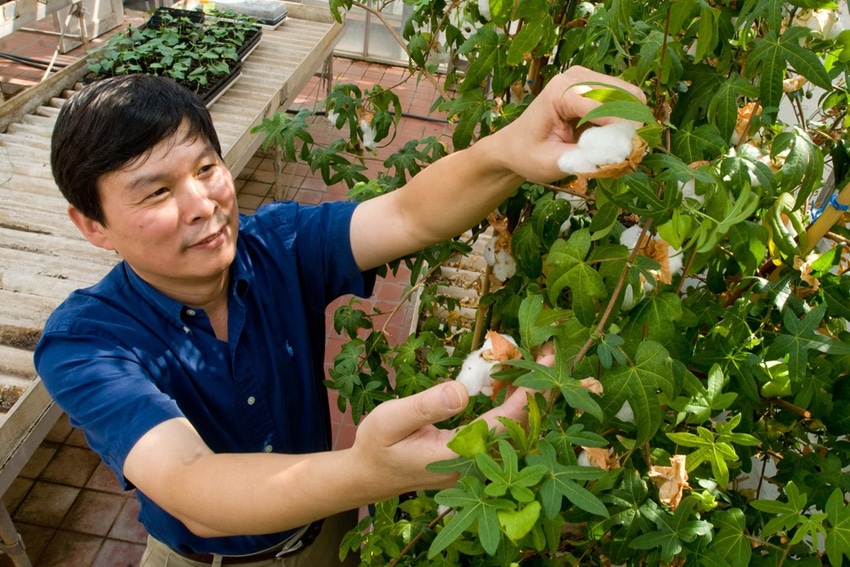June 8, 2017

Imagine it: A variety of cotton that rivals Egyptian cotton, feels good to the skin, uses less water and pesticide, is good to the land and is affordable to grow.
It almost sounds too good to be true, but according to a research scientist at the University of Texas at Austin and his special national and international team, epigenetic modification is a process that represents a first step toward a new way of breeding a heartier and more productive cotton that could provide a major break for U.S. cotton producers.
Dr. Z. Jeff Chen, a D. J. Sibley Centennial Professor in Plant Molecular Genetics at the University of Texas, developed a detailed genetic road map of American cotton earlier this year. That led to assembling a new and international team of researchers to develop the new process of epigenetic modification.
With the help of researchers Tianzhen Zhang and Wangzhen Guo at Nanjing Agricultural University (NAU) in China, and with the input of researchers at Texas A&M University, a program to study molecular mechanisms for gene expression changes and evolutionary consequences in hybrids (formed between strains of the same or different species) and allopolyploids (formed between two or more related species) was launched and has resulted in the award of a $2.3 million National Science Foundation grant designed to take the project to the next step.
SUPERIOR QUALITY COTTON
What this means to cotton producers is the ability to grow a superior cotton breed that makes production affordable while producing a product competitive with the best cotton varieties in the world.
Chen explained that scientists have discovered that many traits in living things are controlled not just by their genetics but also by processes outside their DNA that determine whether, when, and how much the genes are expressed, a process known as epigenetics. By selectively turning gene expression on and off, breeders could create new varieties without altering the genes.
Chen's research team identified more than 500 genes that are epigenetically modified between wild cotton varieties and domesticated cotton, some of which are known to relate to agronomic and domestication traits. This information could aid selection for the kinds of traits that breeders want to alter, like fiber yield or resistance to drought, heat or pests. For example, varieties of wild cotton might harbor genes that help them respond better to drought, but have been epigenetically silenced in domesticated cotton.
Chen described the new draft genomic sequence in a paper published this week in Nature Biotechnology.
The species of cotton Chen’s team is sequencing is Upland (or American) cotton (Gossypium hirsutum), which makes up 95 percent of all cotton grown. A well-defined map of the Upland cotton’s genome would allow researchers and growers to better understand the interactions between genes that determine the species’ ability to produce better fibers and oils in seeds.
"Only about 20-30 percent of the cells on the cotton seed surface actually produce fibers, and no one knows why," said Chen. "Knowing more about the sequence map could allow for more and better cotton to be produced on every seed or plant."
GAME CHANGING RESEARCH
David Stelly of Texas A&M, a collaborator with Chen on both the paper and the new grant, noted that the draft cotton genome sequence will be a "game-changer," launching a new era in cotton research, education and breeding.
"This sequence will accelerate genetic and breeding improvement of cotton production," said Zhang, director of the Cotton Research Institute at NAU.
Researchers used the study to produce "methylome," a list of genes and genetic elements that have been switched on or off through a natural process called DNA methylation. A methylome provides important clues to adapt crops through epigenetic modification. Epigenetic breeding could eventually be applied not just to cotton but also to many other major crops such as corn, potatoes, wheat, canola, coffee, and other crops.
While cotton is the top fiber crop grown in the world, with more than 150 countries involved in cotton export and import, it is one of the major commercial crops in Texas, and contributes an estimated $2 billion per year to the state’s economy. In recent years, however, droughts have resulted in steep losses for Texas cotton farmers.
Overall, annual business revenue stimulated by cotton in the U.S. economy exceeds $100 billion, making it America’s most value-added crop.
The new research from Chen and colleagues was written with contributors in China, Australia and the United States, from Novogene Bioinformatics Institute, Clemson University, Mississippi State University, the U.S. Department of Agriculture, Texas A&M University, Shanghai Institutes for Biological Sciences, Commonwealth Scientific and Industrial Research Organization, and Cotton Incorporated.
U.S. funding for the project came from both the National Science Foundation and from support of Cotton Incorporated.
You May Also Like




